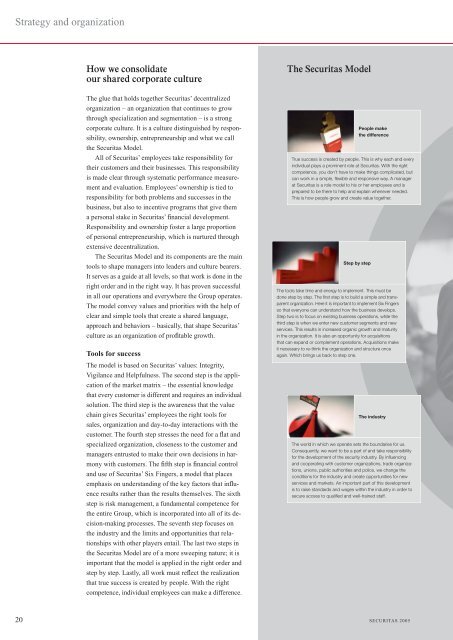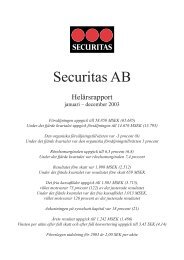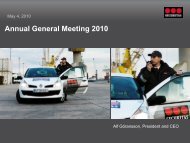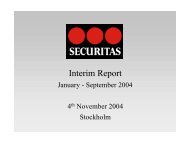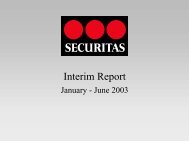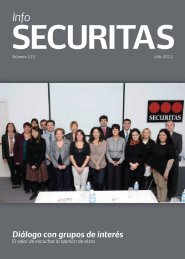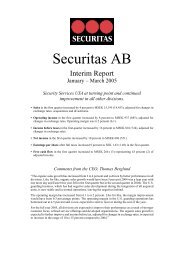Securitas AB Annual Report 2005
Securitas AB Annual Report 2005
Securitas AB Annual Report 2005
Create successful ePaper yourself
Turn your PDF publications into a flip-book with our unique Google optimized e-Paper software.
Strategy and organization<br />
How we consolidate<br />
our shared corporate culture<br />
The glue that holds together <strong>Securitas</strong>’ decentralized<br />
organization – an organization that continues to grow<br />
through specialization and segmentation – is a strong<br />
corporate culture. It is a culture distinguished by responsibility,<br />
ownership, entrepreneurship and what we call<br />
the <strong>Securitas</strong> Model.<br />
All of <strong>Securitas</strong>’ employees take responsibility for<br />
their customers and their businesses. This responsibility<br />
is made clear through systematic performance measurement<br />
and evaluation. Employees’ ownership is tied to<br />
responsibility for both problems and successes in the<br />
business, but also to incentive programs that give them<br />
a personal stake in <strong>Securitas</strong>’ fi nancial development.<br />
Responsibility and ownership foster a large proportion<br />
of personal entrepreneurship, which is nurtured through<br />
extensive decentralization.<br />
The <strong>Securitas</strong> Model and its components are the main<br />
tools to shape managers into leaders and culture bearers.<br />
It serves as a guide at all levels, so that work is done in the<br />
right order and in the right way. It has proven successful<br />
in all our operations and everywhere the Group operates.<br />
The model convey values and priorities with the help of<br />
clear and simple tools that create a shared language,<br />
approach and behaviors – basically, that shape <strong>Securitas</strong>’<br />
culture as an organization of profi table growth.<br />
Tools for success<br />
The model is based on <strong>Securitas</strong>’ values: Integrity,<br />
Vigilance and Helpfulness. The second step is the application<br />
of the market matrix – the essential knowledge<br />
that every customer is different and requires an individual<br />
solution. The third step is the awareness that the value<br />
chain gives <strong>Securitas</strong>’ employees the right tools for<br />
sales, organization and day-to-day interactions with the<br />
customer. The fourth step stresses the need for a fl at and<br />
specialized organization, closeness to the customer and<br />
managers entrusted to make their own decisions in harmony<br />
with customers. The fi fth step is fi nancial control<br />
and use of <strong>Securitas</strong>’ Six Fingers, a model that places<br />
emphasis on understanding of the key factors that infl uence<br />
results rather than the results themselves. The sixth<br />
step is risk management, a fundamental competence for<br />
the entire Group, which is incorporated into all of its decision-making<br />
processes. The seventh step focuses on<br />
the industry and the limits and opportunities that relationships<br />
with other players entail. The last two steps in<br />
the <strong>Securitas</strong> Model are of a more sweeping nature; it is<br />
important that the model is applied in the right order and<br />
step by step. Lastly, all work must refl ect the realization<br />
that true success is created by people. With the right<br />
competence, individual employees can make a difference.<br />
The <strong>Securitas</strong> Model<br />
Step by step<br />
People make<br />
the difference<br />
True success is created by people. This is why each and every<br />
individual plays a prominent role at <strong>Securitas</strong>. With the right<br />
competence, you don’t have to make things complicated, but<br />
can work in a simple, fl exible and responsive way. A manager<br />
at <strong>Securitas</strong> is a role model to his or her employees and is<br />
prepared to be there to help and explain whenever needed.<br />
This is how people grow and create value together.<br />
The tools take time and energy to implement. This must be<br />
done step by step. The fi rst step is to build a simple and transparent<br />
organization. Here it is important to implement Six Fingers<br />
so that everyone can understand how the business develops.<br />
Step two is to focus on existing business operations, while the<br />
third step is when we enter new customer segments and new<br />
services. This results in increased organic growth and maturity<br />
in the organization. It is also an opportunity for acquisitions<br />
that can expand or complement operations. Acquisitions make<br />
it necessary to re-think the organization and structure once<br />
again. Which brings us back to step one.<br />
The industry<br />
The world in which we operate sets the boundaries for us.<br />
Consequently, we want to be a part of and take responsibility<br />
for the development of the security industry. By infl uencing<br />
and cooperating with customer organizations, trade organizations,<br />
unions, public authorities and police, we change the<br />
conditions for the industry and create opportunities for new<br />
services and markets. An important part of this development<br />
is to raise standards and wages within the industry in order to<br />
secure access to qualifi ed and well-trained staff.<br />
20 SECURITAS <strong>2005</strong>


